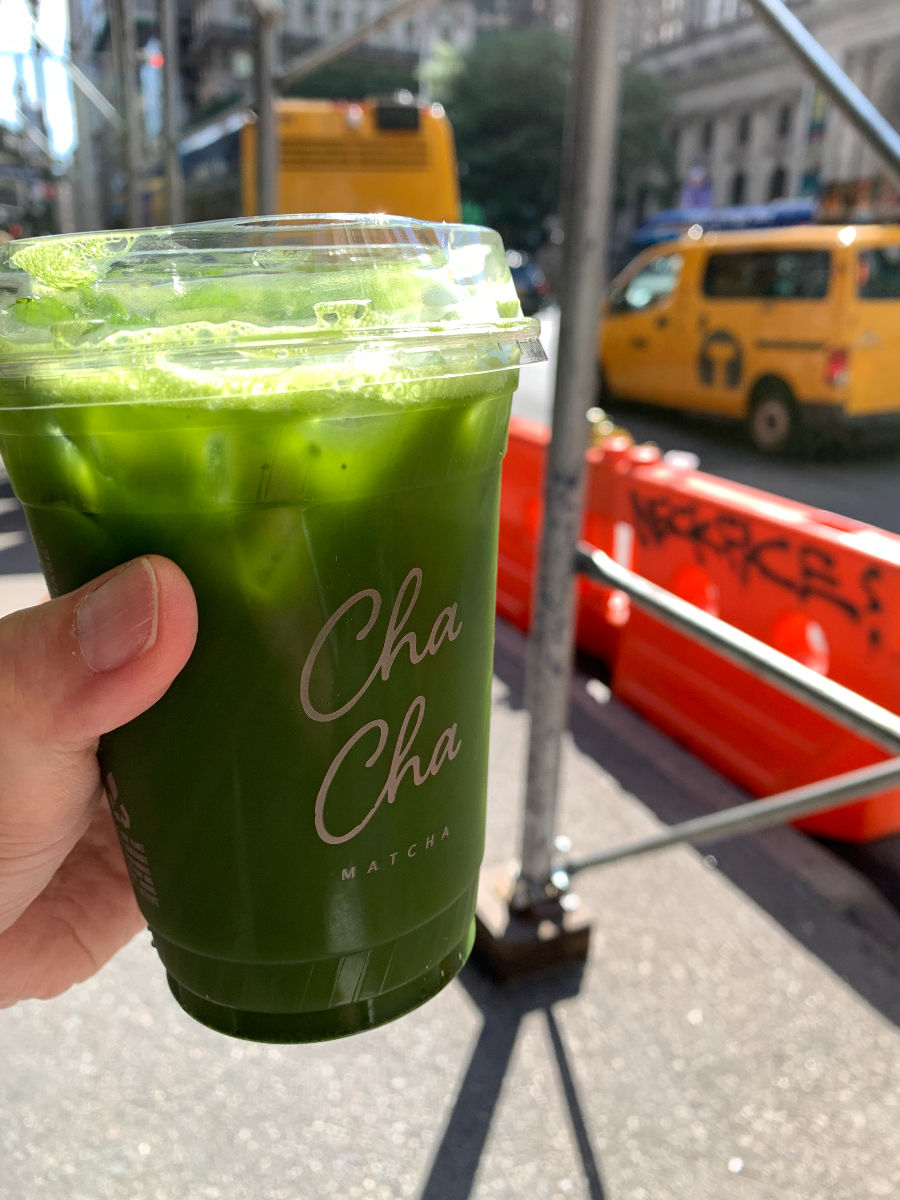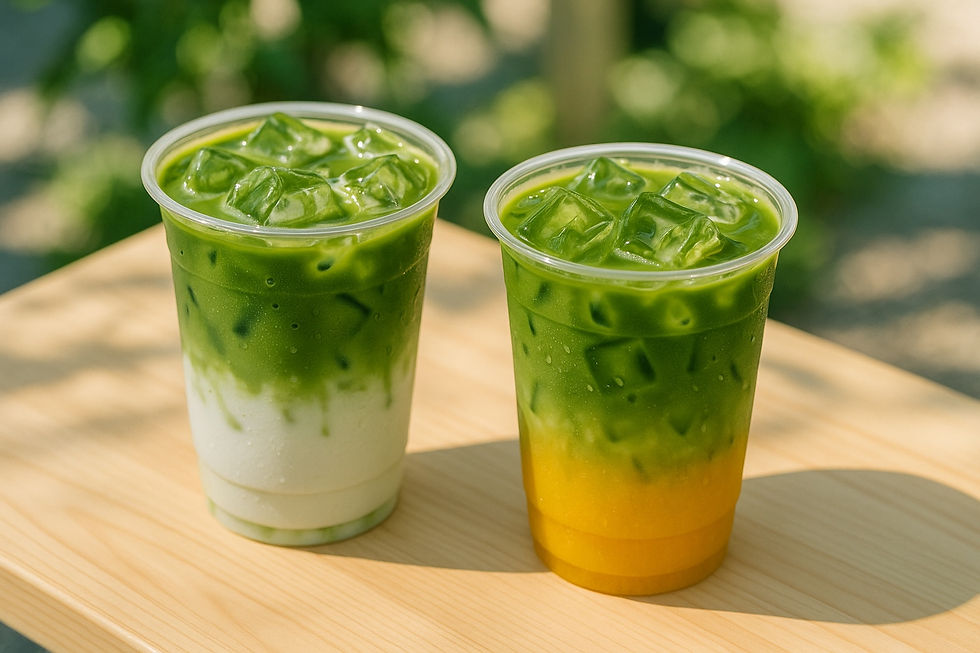The Matcha Boom and Bust: How Global Demand Is Disrupting Japanese Green Tea Culture
- mikster
- Jun 21
- 6 min read
Updated: Jun 22
A More Mindful Generation Can Help Protect What They Love

Two years ago, I was walking through New York City when I noticed a wave of green sweeping the streets— matcha cafés were everywhere. But these weren’t quiet tea rooms offering traditional whisked tea. They were full-on specialty shops with long queues and colorful menus: matcha lattes mixed with oat milk, matcha lemonade, strawberry matcha smoothies, even parfaits and chia puddings. The drinks were vibrant, the interiors perfectly curated for Instagram, and the buzz was everywhere.
At the time, it was exciting to see this much global love for Japanese matcha. And I savored my first ever matcha-lemonade in a clear plastic sippy cup.
But just last month, back in Japan, I sat down with a heritage pottery family who specializes in making tea ceremony wares including the chawan tea bowls. We shared a growing concern: tea ceremony practitioners, traditional craft industry, and tea suppliers in Japan are having trouble getting the matcha powder they need. We went on to discuss the surprise they experienced using a plastic tea whisk for the first time, at a traditional tea ceremony event which the organizer ordered from Amazon.
The tea world is swiftly evolving while we all live quietly in the traditional craft world. And now I’ve felt it myself. It used to be very easy to pick up a small tin of matcha from a local supermarket tea counter or shotengai tea shop, but now the shelves are empty.
So what happened?
When a Cultural Export Becomes a Cultural Emergency

In the last few years, matcha green-tea powder has become more than tea—it’s been swept into the global wellness trend and labeled a superfood. It makes kombucha, spirulina, wheat-grass and acai look jurassic on Pinterest boards. Social media is now saturated with contents about whisking matcha lattes, matcha smoothies, matcha pancakes, matcha tiramisu, matcha outings and parties, created by both individuals and businesses. Online shops compete to showcase “the greenest Japanese matcha for lattes” or “ceremonial grade matcha beverages in posh cafes.”
But in the rush to celebrate matcha abroad, we’re now facing a quiet crisis at home.
Japan is experiencing serious matcha shortage. Tea farmers in Uji, Shizuoka, Yame, and other historic regions are overwhelmed by demand. High-quality Japanese matcha, which was traditionally sold in small tins for respectful tea ceremonies and for individuals to savor, is being snapped up in large quantities to serve sweetened drinks and puddings. The crave is particular for "ceremonial-grade" matcha powders—carefully grown and stone-milled— which are being dunk into milk with syrups, turned into frappés, flavored desserts, and social media challenges.

The situation is further amplified by inbound tourism and a weakened yen. International visitors are flocking to Japanese tea shops in Kyoto, Tokyo, and Uji, wiping shelves clean and stock-piling on matcha to bring home or resell. ( Who drank all the green tea? BBC )
When supply can't meet demand caused by over-consumption, local users—those who preserve the culture of tea—are pushed to the margins. Small tea schools, potters, and bamboo whisk makers are struggling to continue their practices. Sellers started designing their own brand and packaging with OEM tea products they procured. The content and labeling is largely unregulated. Products labeled as "Premium", "Ceremonial", “Uji matcha” or “Kyoto matcha” but grown or packaged abroad have started to flood the market, making it even harder for consumers to buy matcha with confidence.
Social Media: A Powerful Tool—for Education or Erosion
Much of this phenomenon is being fueled by social media. Platforms like TikTok and Instagram have made matcha lattes synonymous with hipster's lifestyle and wellness content. Once I started researching about this matcha situation on the internet, I was immediately bombarded by contents: tutorials about whisking the perfect froth, unending reels featuring cafés and seller securing and restocking 20kg of matcha, influencers unboxing their 1kg “ceremonial grade” hauls at home, influencer whisking matcha inside a flight cabin, chia seed matcha pudding recipes...etc. But while visibility can be good, virality without cultural understanding can do a lot of damage.
Even well-meaning content can unintentionally distort the story. When posts center on how much matcha someone owns, or how many tins a café has "secured", they reinforce a scarcity mindset and encourage hoarding.
When everyone is trying to buy matcha fast, local users lose out, at the same time stressing the tea industry and growers. Social media isn’t the enemy—it’s the amplifier. The question is: what do content creators choose to amplify?
The Generation With the Power to Protect It
In fact, the same generation behind this matcha boom is also one of the most socially conscious in history.
Gen Z and Millennials can be thoughtful, curious, and connected. They care about climate, culture, and craftsmanship. They support small businesses, slow fashion, farm-to-table food, and independent creators.
This social-conscious generation doesn’t need to be told what to stop doing. It just needs to be reminded of what it already values: authenticity, intentionality, responsibility and respect.
And when it comes to Japanese matcha, these values matter now more than ever.
If You Love Matcha, Here's How to Protect It
If you’re someone who enjoys a good matcha latte or any matcha products, these five small shifts can make a big difference:


Be reminded the power you hold on social media.
What you choose to express or announce on a public platform could drive positive or negative impacts. Be mindful on your messaging and the intention.
Rethink the haul culture.
You don’t need 1kg of matcha at home. It’s fragile, sensitive to oxidation, and meant to be consumed fresh. Tell story of less excess. Let your post say: “Less is more” rather than “Look how much I got.”
Use your influence to educate.
Spotlight the craft history and growers. Share who made your chawan and the cultural value of other tea utensils. Rather than joining the hype, set a different tone of message about consumption responsibility and cultural consciousness.
Protect the spirit of craft.
Japan is known and loved for producing things slowly, with heart and soul. From pottery to green tea, the value lies in its delicacy. If we push this tradition toward mass production, it will lose what made it special in the first place.
We’re seeing “Japanese matcha” branded products which are produced outside of Japan. If we lose sight of the tradition, matcha will become just another globalized flavor—stripped of its roots. And while Japan could scale up matcha production using advanced technology, we must ask: Should it? Matcha, whether served as a meditative tea or as a fun beverage, is not La Bubu.
Adjust the mindset of "Chasing for Premium".
Different matcha "grades" serve different purposes. This grading is a non-regulated system written by westerners and adopted by suppliers. And the term "grade" systematically created hierarchy for matcha products. Often, “Ceremonial-grade” is prized for its taste, aroma, and vibrant color— suitable for tea ceremony use when direct presentation and taste of pure green tea is essential. Culinary grade with different flavor profile is perfectly suitable for baking, confectionary, or sugary mixed beverages where matcha is just one note in the recipe. However, when latte cafes stressing on "we only use ceremonial-grade matcha", it is misguiding consumers. The more we understand, the more we preserve.
Slow Down and Savor the Finer Things
There’s a reason people around the world love Japanese culture. It’s not just because it looks beautiful—it’s because it feels meaningful. Every bowl, every scoop, every gesture is done with care. Matcha is part of that. It’s not just something you put on a show for social media; it’s something you experience.
When we protect the spirit of matcha, we’re protecting more than tea—we’re honoring a worldview that embraces slowness, attention to detail, and a connection between maker and user.
Let's not turn your matcha excitement into Labubu frenzy, or pain-killer, hand-sanitizer, face-mask and toilet paper hoarding scenes during the pandemic.
Take a moment. To pause. To savor. To reflect on how we’re consuming—and why.
The world doesn’t need more content. It needs more care.
Comment and let us know if you are interested in learning more about the world of tea ceremony and all the artisans within its ecosystem.





Comments